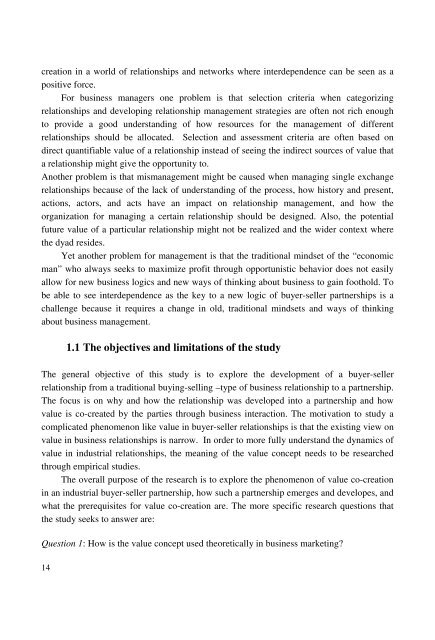Value Co-Creation in Industrial Buyer-Seller Partnerships ... - Doria
Value Co-Creation in Industrial Buyer-Seller Partnerships ... - Doria
Value Co-Creation in Industrial Buyer-Seller Partnerships ... - Doria
- No tags were found...
You also want an ePaper? Increase the reach of your titles
YUMPU automatically turns print PDFs into web optimized ePapers that Google loves.
creation <strong>in</strong> a world of relationships and networks where <strong>in</strong>terdependence can be seen as apositive force.For bus<strong>in</strong>ess managers one problem is that selection criteria when categoriz<strong>in</strong>grelationships and develop<strong>in</strong>g relationship management strategies are often not rich enoughto provide a good understand<strong>in</strong>g of how resources for the management of differentrelationships should be allocated. Selection and assessment criteria are often based ondirect quantifiable value of a relationship <strong>in</strong>stead of see<strong>in</strong>g the <strong>in</strong>direct sources of value thata relationship might give the opportunity to.Another problem is that mismanagement might be caused when manag<strong>in</strong>g s<strong>in</strong>gle exchangerelationships because of the lack of understand<strong>in</strong>g of the process, how history and present,actions, actors, and acts have an impact on relationship management, and how theorganization for manag<strong>in</strong>g a certa<strong>in</strong> relationship should be designed. Also, the potentialfuture value of a particular relationship might not be realized and the wider context wherethe dyad resides.Yet another problem for management is that the traditional m<strong>in</strong>dset of the “ economicman” who always seeks to maximize profit through opportunistic behavior does not easilyallow for new bus<strong>in</strong>ess logics and new ways of th<strong>in</strong>k<strong>in</strong>g about bus<strong>in</strong>ess to ga<strong>in</strong> foothold. Tobe able to see <strong>in</strong>terdependence as the key to a new logic of buyer-seller partnerships is achallenge because it requires a change <strong>in</strong> old, traditional m<strong>in</strong>dsets and ways of th<strong>in</strong>k<strong>in</strong>gabout bus<strong>in</strong>ess management.141.1 The objectives and limitations of the studyThe general objective of this study is to explore the development of a buyer-sellerrelationship from a traditional buy<strong>in</strong>g-sell<strong>in</strong>g –type of bus<strong>in</strong>ess relationship to a partnership.The focus is on why and how the relationship was developed <strong>in</strong>to a partnership and howvalue is co-created by the parties through bus<strong>in</strong>ess <strong>in</strong>teraction. The motivation to study acomplicated phenomenon like value <strong>in</strong> buyer-seller relationships is that the exist<strong>in</strong>g view onvalue <strong>in</strong> bus<strong>in</strong>ess relationships is narrow. In order to more fully understand the dynamics ofvalue <strong>in</strong> <strong>in</strong>dustrial relationships, the mean<strong>in</strong>g of the value concept needs to be researchedthrough empirical studies.The overall purpose of the research is to explore the phenomenon of value co-creation<strong>in</strong> an <strong>in</strong>dustrial buyer-seller partnership, how such a partnership emerges and developes, andwhat the prerequisites for value co-creation are. The more specific research questions thatthe study seeks to answer are:Question 1: How is the value concept used theoretically <strong>in</strong> bus<strong>in</strong>ess market<strong>in</strong>g?
















